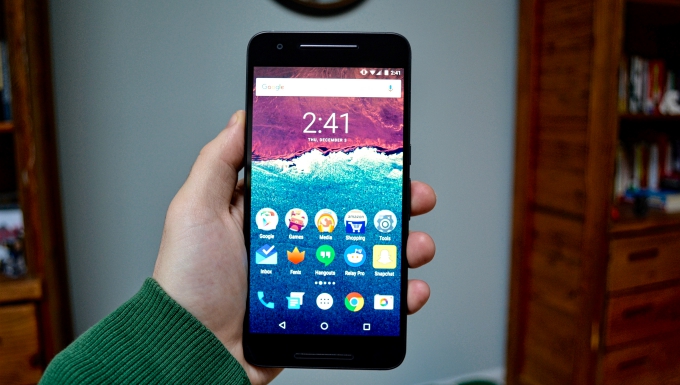Nexus 6P: The Best of Android
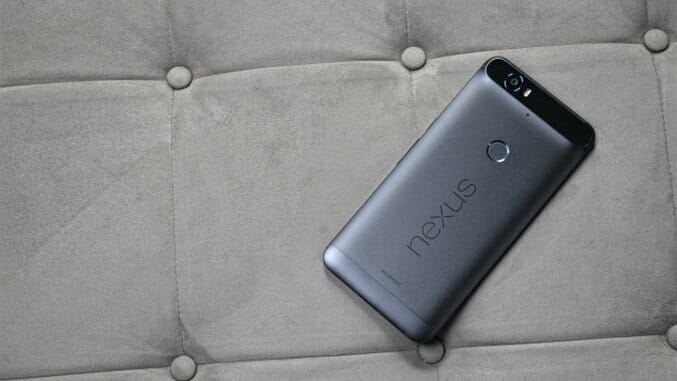
Google, by many accounts, lost its way with last year’s Motorola-built Nexus 6. The nearly 6-inch behemoth was too much phone for most and came at an uncharacteristically high $649. This year, the company cast as wide a net as possible, following the footsteps of Samsung and Apple, releasing two new devices. It returned to LG for the budget-conscious Nexus 5X, a spiritual successor to the most popular Nexus device in history, but surprised many by teaming with Chinese phone maker Huawei for the more premium choice, the Nexus 6P.
As important as the 6P is for Google, being the first unequivocally premium Nexus device, it’s just as influential for the future of Huawei. The company has quietly built solid phones a world away for years, but failed to get any real traction in a U.S. market dominated by Apple and, to a much lesser extent, Samsung. The 6P won’t get Huawei a vast market share, that’s not what Nexuses do, but it could open doors if the company delivers.
In the past, the Nexus line reflected Google’s vision for an affordable approach to smartphones. In 2015, Mountain View is here to play offering a premium, all-around phone that’s gunning for the “Best Android Smartphone” title and deserves everyone’s attention.
Hardware
Like many, my initial reaction to the Nexus 6P was akin to a toddler staring down a plate of Brussels sprouts. The main culprit was the unsightly glass bar housing the camera module, laser autofocus and a bevy of antennas and sensors that allow the phone to function. It’s a necessary evil, and after spending a wealth of time with the 6P, I can confidently say it grows on you.
Most users will cover it with a case as it is, but the bar doesn’t jut out as far as it appears in photos, and gives the phone a distinctive, bold look that most manufacturers shy away from. The device doesn’t tilt significantly on a flat surface, but if it is a bother, I’d suggest picking up the Graphite version, which dulls the contrast between the aluminum back and glass.
 My least favorite design choice isn’t the glass bar, but a plastic panel near the bottom. While another necessary evil, the panel disrupts the aluminum construction and the colors don’t quite match, making it an eyesore in person.
My least favorite design choice isn’t the glass bar, but a plastic panel near the bottom. While another necessary evil, the panel disrupts the aluminum construction and the colors don’t quite match, making it an eyesore in person.
 That said, any dissatisfaction with the design and build of the 6P is nothing more than a nitpick. Huawei has done a masterful job. The device feels phenomenal in the hand with a definite heft so as not to feel fragile, but light enough at 178 grams so you won’t tire. It’s incredibly thin, just 7.3mm, which, when coupled with petite bezels, makes the 5.7-inch screen manageable. Even as a person with moderate-to-small hands, the 6P’s screen size, for me, is reasonable to use, with some finagling, in one hand.
That said, any dissatisfaction with the design and build of the 6P is nothing more than a nitpick. Huawei has done a masterful job. The device feels phenomenal in the hand with a definite heft so as not to feel fragile, but light enough at 178 grams so you won’t tire. It’s incredibly thin, just 7.3mm, which, when coupled with petite bezels, makes the 5.7-inch screen manageable. Even as a person with moderate-to-small hands, the 6P’s screen size, for me, is reasonable to use, with some finagling, in one hand.
The front of the device is a simplistic slab of Gorilla Glass 4, the only pronounced feature being the dual, front-facing speakers. Kudos to Google and Huawei for including them, a trait that should be more prominent among the very best smartphones. The speakers are loud and crisp, offering great sound for a mobile device. They make all entertainment, but especially gaming, more immersive and pleasant. As with any glass front, the Nexus 6P is prone to smudges, though it isn’t nearly as bad as the OnePlus X.
 One of the biggest additions to this year’s line of Nexus devices is the new fingerprint scanner, dubbed Nexus Imprint. The curious choice here is placement. Instead of, like many companies, placing the scanner on the front of the device, Huawei and Google opted to incorporate it on the back. I was skeptical at first, but the location is nearly perfect. It sits exactly where my index finger naturally rests when I pick up the phone, the only problem being that I have to pick it up in order to use it.
One of the biggest additions to this year’s line of Nexus devices is the new fingerprint scanner, dubbed Nexus Imprint. The curious choice here is placement. Instead of, like many companies, placing the scanner on the front of the device, Huawei and Google opted to incorporate it on the back. I was skeptical at first, but the location is nearly perfect. It sits exactly where my index finger naturally rests when I pick up the phone, the only problem being that I have to pick it up in order to use it.
Any inconvenience caused when using the device on a desk is made up for by the scanner’s speed and precision. It’s one of, if not the, fastest scanners I’ve used. When it read my print incorrectly, which it rarely did, it was usually because of user error. I never saw the lock screen unless I intended to, most often zipping past it directly to my home screen.
-

-

-

-

-

-

-

-

-

-

-

-

-

-

-

-

-

-

-

-

-

-

-

-

-

-

-

-

-

-

-

-

-

-

-

-

-

-

-

-

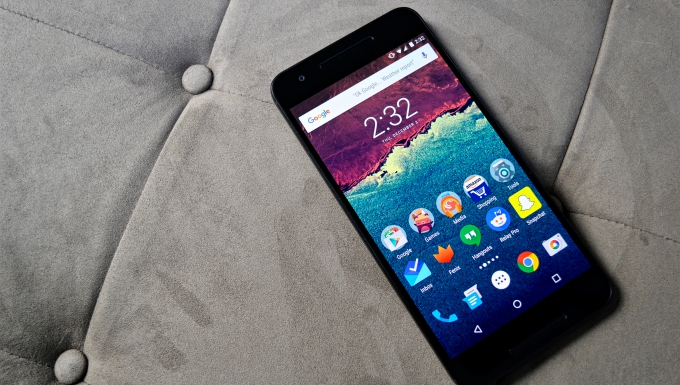 For all its hardware achievements, the 6P’s 5.7-inch QHD screen is the star of the show. It’s one of the best displays you’ll find on any smartphone, with vivid colors and deep blacks that bleed into the glass front, making the entire thing look like one massive display. Every task is improved because of it, and it’s the thing people first notice when you hand them the phone. I was saddened by how quickly my eyes adjusted to it, but am easily reminded how wonderful it is the minute I pick up a device with a lesser panel. It is perhaps a touch behind the latest Galaxy phones, but not by much. There is simply nothing to complain about. Some users report a pink tint, most apparent with white tones, but I’ve had no such issues to.
For all its hardware achievements, the 6P’s 5.7-inch QHD screen is the star of the show. It’s one of the best displays you’ll find on any smartphone, with vivid colors and deep blacks that bleed into the glass front, making the entire thing look like one massive display. Every task is improved because of it, and it’s the thing people first notice when you hand them the phone. I was saddened by how quickly my eyes adjusted to it, but am easily reminded how wonderful it is the minute I pick up a device with a lesser panel. It is perhaps a touch behind the latest Galaxy phones, but not by much. There is simply nothing to complain about. Some users report a pink tint, most apparent with white tones, but I’ve had no such issues to.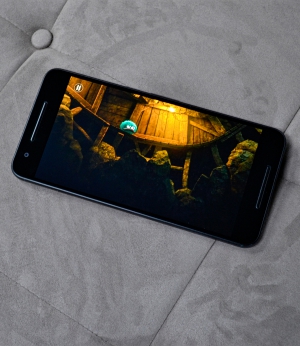 Another notable change with Nexus devices this year is the inclusion of USB Type-C for charging. It might cause minor inconveniences, given that essentially no one has USB-C gear, meaning you’ll have to be diligent about packing all the necessary cords when travelling, but the benefits of reversibility and quick-charging are enough to remedy those issues. Plus, in a few years USB-C will be the standard, and you’ll have a head start in the conversion process.
Another notable change with Nexus devices this year is the inclusion of USB Type-C for charging. It might cause minor inconveniences, given that essentially no one has USB-C gear, meaning you’ll have to be diligent about packing all the necessary cords when travelling, but the benefits of reversibility and quick-charging are enough to remedy those issues. Plus, in a few years USB-C will be the standard, and you’ll have a head start in the conversion process.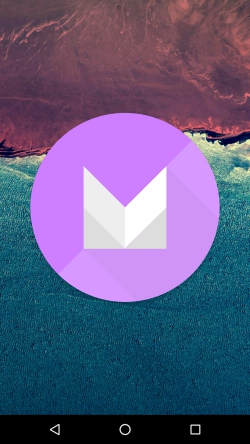 As I wrote in my
As I wrote in my  Another big addition to Android is the ability to choose individual app permissions. It doesn’t add any flash to your daily use of the phone, but will give more security. If you don’t want Chrome accessing your camera, toggle a switch in the settings and ease your mind.
Another big addition to Android is the ability to choose individual app permissions. It doesn’t add any flash to your daily use of the phone, but will give more security. If you don’t want Chrome accessing your camera, toggle a switch in the settings and ease your mind. The one confusing hiccup that consistently caused issues for the 6P was the camera app. It’s odd a stock app would trip the phone up, given the horsepower inside, but it does. The app can be slow to launch, and slow to capture an image, meaning users may miss a shot or two. You can double-tap the power button to launch the app, which works decently, but is still prone to the lag. The good news is that this can all be remedied with a software update, and Google is likely hard at work improving the situation.
The one confusing hiccup that consistently caused issues for the 6P was the camera app. It’s odd a stock app would trip the phone up, given the horsepower inside, but it does. The app can be slow to launch, and slow to capture an image, meaning users may miss a shot or two. You can double-tap the power button to launch the app, which works decently, but is still prone to the lag. The good news is that this can all be remedied with a software update, and Google is likely hard at work improving the situation.